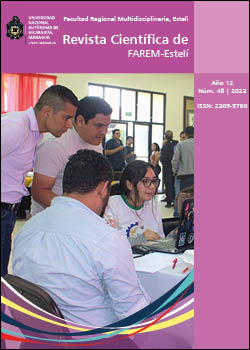Relación del estrés laboral y sindrome metabolico en personal de una clinica laboral. Nicaragua. Marzo abril 2022
DOI:
https://doi.org/10.5377/farem.v12i48.17509Palabras clave:
Estrés laboral, trastorno, metabólicoResumen
El presente artículo tiene como objetivo analizar la relación del estrés laboral y el síndrome metabólico en el personal que labora en una Clínica Médica Laboral Nicaragua, marzo-abril del 2022. Se desarrolló un estudio cuantitativo de tipo descriptivo correlacional. El área de estudio fue una Clínica Médica Laboral y la muestra fue constituida por 26 personas. Entre los resultados se encuentran que el 50% (13) están en el rango de edad de 30 a 39 años ,38% (10) presentaban un nivel moderado de estrés, 35 % (9) tenían un nivel intermedio de estrés, 19 % (5) un nivel bajo de estrés y tan solo el 8% (2) presentaron un nivel alto de estrés. No se encontró asociación estadísticamente significativa entre los que tenían con síndrome metabólico con estrés laboral, p = 0.803. Los cargos que predominaron con mayor nivel de estrés fueron: laboratoristas, gerente y administrador, médicos y enfermeras. El área que obtuvo mayor nivel de estrés (moderado) fue la de laboratorio y dirección médica con un nivel de estrés intermedio. Entre las conclusiones con respecto a las características sociolaborales, el sexo que predominó fue el femenino entre las edades de 30 a 39 años, profesión laboratorista con menos de 3 años de laborar y este personal era parte del área de administración. El nivel de estrés laboral con mayor frecuencia fue el moderado seguido del intermedio. Los cargos que predominaron con mayor de nivel de estrés fueron: laboratoristas, gerente y administrador. El área con mayor nivel de estrés (moderado) fue la de laboratorio, seguido de dirección médica con nivel de estrés intermedio. No se encontró asociación estadísticamente significativa entre el nivel de estrés laboral que posee el personal en estudio con el síndrome metabólico.
Descargas
399
HTML 155
Publicado
Cómo citar
Número
Sección
Licencia
Derechos de autor 2024 Revista Científica de FAREM-Estelí

Esta obra está bajo una licencia internacional Creative Commons Atribución-NoComercial-CompartirIgual 4.0.
© Revista Científica de FAREM-Estelí

